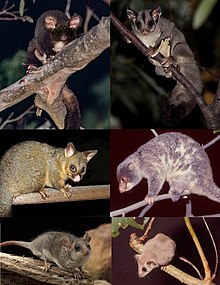
Back بوسوم Arabic بوسوم (رتيبه) ARZ Посуми Bulgarian Pòssums Catalan Possum German Posumo Esperanto Phalangeriformes Spanish Phalangeriformes Basque صاریغ استرالیایی Persian Phalangeriformes French
| Phalangeriformes Temporal range:
| |
|---|---|

| |
| Scientific classification | |
| Domain: | Eukaryota |
| Kingdom: | Animalia |
| Phylum: | Chordata |
| Class: | Mammalia |
| Infraclass: | Marsupialia |
| Order: | Diprotodontia |
| Suborder: | Phalangeriformes Szalay in Archer, 1982 |
| Groups included | |
| Cladistically included but traditionally excluded taxa | |
Phalangeriformes /fəˈlændʒərɪfɔːrmiːz/ is a paraphyletic[1] suborder of about 70 species of small to medium-sized arboreal marsupials native to Australia, New Guinea, and Sulawesi.[2] The species are commonly known as possums, gliders, and cuscus. The common name "possum" for various Phalangeriformes species derives from the creatures' resemblance to the opossums of the Americas (the term comes from Powhatan language aposoum "white animal", from Proto-Algonquian *wa·p-aʔɬemwa "white dog"). However, although opossums are also marsupials, Australasian possums are more closely related to other Australasian marsupials such as kangaroos.
Phalangeriformes are quadrupedal diprotodont marsupials with long tails. The smallest species, indeed the smallest diprotodont marsupial, is the Tasmanian pygmy possum, with an adult head-body length of 70 mm (2+3⁄4 in) and a weight of 10 g (3⁄8 oz). The largest are the two species of bear cuscus, which may exceed 7 kg (15 lb 7 oz). Phalangeriformes species are typically nocturnal and at least partially arboreal. They inhabit most vegetated habitats, and several species have adjusted well to urban settings. Diets range from generalist herbivores or omnivores (the common brushtail possum) to specialist browsers of eucalyptus (greater glider), insectivores (mountain pygmy possum) and nectar-feeders (honey possum).
- ^ Eldridge, Mark D B; Beck, Robin M D; Croft, Darin A; Travouillon, Kenny J; Fox, Barry J (23 May 2019). "An emerging consensus in the evolution, phylogeny, and systematics of marsupials and their fossil relatives (Metatheria)". Journal of Mammalogy. 100 (3): 802–837. doi:10.1093/jmammal/gyz018. ISSN 0022-2372.
- ^ Groves, C. P. (2005). "Suborder Phalangeriformes". In Wilson, D. E.; Reeder, D. M (eds.). Mammal Species of the World: A Taxonomic and Geographic Reference (3rd ed.). Johns Hopkins University Press. pp. 44–56. ISBN 978-0-8018-8221-0. OCLC 62265494.